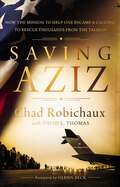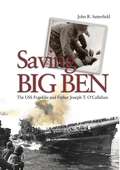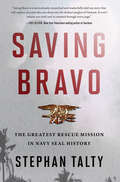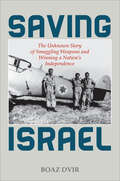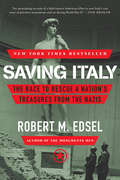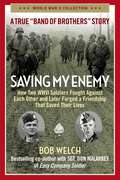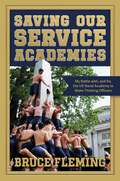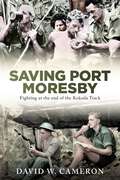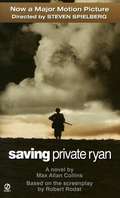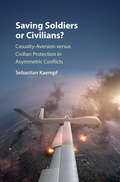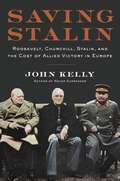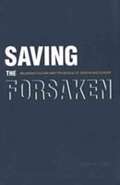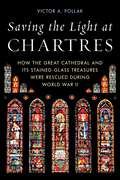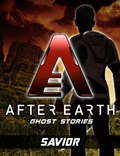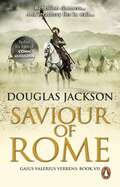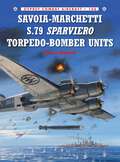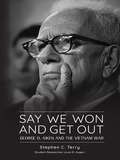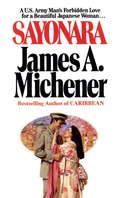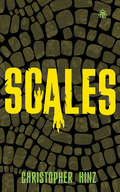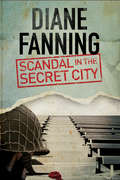- Table View
- List View
Saving Aziz: How the Mission to Help One Became a Calling to Rescue Thousands from the Taliban
by Chad RobichauxIt was the right thing to do. And someone had to do it.Aziz was more than an interpreter for Force Recon Marine Chad Robichaux during Chad's eight deployments to Afghanistan. He was a teammate, brother, and friend. More than once, Aziz saved Chad's life. And then he needed Chad to save his.When President Joe Biden announced in April 2021 that the United States would be making a hasty withdrawal from Afghanistan, Robichaux knew he had to get Aziz and his family out before Taliban forces took over the country. As the rescue team he'd pulled together began to go to work, they became aware of thousands more--US citizens, Afghan allies, women, and children--facing persecution or death if they were not saved from the Taliban's terrorist regime. Chad began leading the charge that would go on to rescue 17,000 evacuees within a few short weeks--12,000 of them within the first ten days.This gripping account of two heroes and a daring mission puts human hearts and names alongside the headlines of one of the most harrowing moments in our history, giving you a closer look at:The resilience of Afghanistan and its peopleChad's direct interactions with the TalibanThe twenty-year war that took place under four presidentsSaving Aziz is a story of war and rescue. It is a story of a mission accomplished and work still to be done. It is a story of how looking into a stranger's eyes breaks down prejudice and apathy--and why risking it all is worth it when it comes to loving one another.Praise for Saving Aziz:"Saving Aziz is the story of two warriors...brought together by war and a brotherhood forged through years of battling...for the cause of freedom and captures the heroic efforts of those who took action to not only rescue Aziz and his family in the US withdrawal but thousands of others."--Tim Kennedy, New York Times bestselling author, US Army Special Forces, Sniper, UFC Fighter, Founder of Sheepdog Response, and Co-Founder of Save Our Allies
Saving Big Ben
by John R. SatterfieldFather Joseph T. O'Callahan was the first military chaplain to receive the Medal of Honor. An unlikely war hero, the bespectacled math professor who became the U.S. Navy's first Jesuit chaplain, served in combat in both the Atlantic and Pacific theaters. He was on board the USS Franklin, an aircraft carrier known as "Big Ben," in the Okinawa campaign in early 1945 when a kamikaze attack nearly destroyed the ship and killed hundreds of sailors. As the Franklin lay dead in the water, consumed by flames and drifting toward Japan, the chaplain organized fire-fighting crews and ministered to the injured and dying. The carrier's captain called "Father Joe" the bravest man he ever knew.To document the Franklin's ordeal and the chaplain's actions, the author draws on interviews with survivors and O'Callahan's family and many unpublished sources.
Saving Bravo: The Greatest Rescue Mission in Navy SEAL History
by Stephan TaltyThe untold story of the most important rescue mission not just of the Vietnam War, but the entire Cold War: one American aviator, who knew our most important secrets, crashed behind enemy lines and risked capture by both the North Vietnamese and the Soviets. One Navy SEAL and his Vietnamese partner had to sneak past them all to save him.At the height of the Vietnam War, few American airmen are more valuable than Lt. Colonel Gene Hambleton. His memory is filled with highly classified information that the Soviets and North Vietnamese badly want. When Hambleton is shot down in the midst of North Vietnam’s Easter Offensive, US forces place the entire war on hold to save a single man hiding amongst 30,000 enemy troops and tanks. Airborne rescue missions fail, killing eleven Americans. Finally, Navy SEAL Thomas Norris and his Vietnamese guide, Nguyen Van Kiet, volunteer to go after him on foot. Gliding past hundreds of enemy soldiers, it takes them days to reach Hambleton, who, guided toward his rescuers via improvised radio code, is barely alive, deeply malnourished, and hallucinating after eleven days on the run. In this deeply-researched, untold story, award-winning author Stephan Talty describes the extraordinary mission that led Hambleton to safety. Drawing from dozens of interviews and access to unpublished papers, Saving Bravo is the riveting story of one of the greatest rescue missions in the history of the Special Forces.
Saving Britain's Art Treasures
by N. J. McCamleyThis book explains for the first time the full story of the wartime adventures of Britain's greatest art treasures. At first the pictures and other artifacts were distributed amongst a number of large country houses. Initially the owners of these houses almost fought one another for the right to house the Treasures. Later, when further accommodation was needed for treasures from the provincial museums, the tables turned and the Office of Works was reduced to bribing owners by promising that they would be spared billetees, and that their houses would be immune from requisitioning. By mid 1940 however, circumstances transpired that made the country houses untenable. German air bases in northern France made the whole of Britain vulnerable. Eventually two deep underground repositories were constructed, one in Wales and one in Wiltshire, and by the end of 1942 virtually all the cultural heritage of the nation was concentrated there. Building and operation of these underground treasure houses did not, however, go smoothly, as described here.
Saving Israel: The Unknown Story of Smuggling Weapons and Winning a Nation's Independence
by Boaz DvirThe incredible true story of a WWII veteran&’s renegade operation to help Israel defend itself during the First Arab-Israeli War. Shortly after Israel was created in 1948, it faced the threat of invasion by five well-equipped neighboring armies. Though the United States opposed supplying arms to either side of the conflict, American World War II veteran Al Schwimmer was determined to do whatever it takes to help Israel defend herself. Schwimmer created factitious airlines, bought decommissioned airplanes from the government, and sent his pilots to pick up rifles, bullets, and fighter planes from the only country willing to break the international arms embargo: communist Czechoslovakia. Schwimmer and his team risked their lives, freedom, and US citizenship to prevent what they viewed as an imminent genocide. They evaded the FBI and State Department, gained the support of the mafia, smuggled weapons—mostly Nazi surplus—across hostile territories, and went into combat in the Middle East. This book vividly tells the story of this little-known yet historically significant mission.
Saving Italy: The Race to Rescue a Nation's Treasures from the Nazis
by Robert M. EdselFrom the author of the #1 New York Times bestseller The Monuments Men "An astonishing account of a little-known American effort to save Italy's...art during World War II."--Tom Brokaw When Hitler's armies occupied Italy in 1943, they also seized control of mankind's greatest cultural treasures. As they had done throughout Europe, the Nazis could now plunder the masterpieces of the Renaissance, the treasures of the Vatican, and the antiquities of the Roman Empire. On the eve of the Allied invasion, General Dwight Eisenhower empowered a new kind of soldier to protect these historic riches. In May 1944 two unlikely American heroes--artist Deane Keller and scholar Fred Hartt--embarked from Naples on the treasure hunt of a lifetime, tracking billions of dollars of missing art, including works by Michelangelo, Donatello, Titian, Caravaggio, and Botticelli. With the German army retreating up the Italian peninsula, orders came from the highest levels of the Nazi government to transport truckloads of art north across the border into the Reich. Standing in the way was General Karl Wolff, a top-level Nazi officer. As German forces blew up the magnificent bridges of Florence, General Wolff commandeered the great collections of the Uffizi Gallery and Pitti Palace, later risking his life to negotiate a secret Nazi surrender with American spymaster Allen Dulles. Brilliantly researched and vividly written, the New York Times bestselling Saving Italy brings readers from Milan and the near destruction of The Last Supper to the inner sanctum of the Vatican and behind closed doors with the preeminent Allied and Axis leaders: Roosevelt, Eisenhower, and Churchill; Hitler, Göring, and Himmler. An unforgettable story of epic thievery and political intrigue, Saving Italy is a testament to heroism on behalf of art, culture, and history.
Saving My Enemy: How Two WWII Soldiers Fought Against Each Other and Later Forged a Friendship That Saved Their Lives
by Bob Welch&“A quintessential tale. Once read, never to be forgotten.&” —Erik Jendersen, lead writer of Band of Brothers on HBOSaving My Enemy is a &“Band of Brothers&” sequel like no other.Don Malarkey grew up scrappy and happy in Astoria, Oregon—jumping off roofs, playing pranks, a free-range American.Fritz Engelbert&’s German boyhood couldn&’t have been more different. Regimented and indoctrinated by the Hitler Youth, he was introspective and a loner.Both men fought in the Battle of the Bulge, the horrific climax of World War II in Europe. A paratrooper in the U.S. Army, Malarkey served a longer continuous stretch on the bloody front lines than any man in Easy Company. Engelbert, though he never killed an enemy soldier, spent decades wracked by guilt over his participation in the Nazi war effort.On the sixtieth anniversary of the start of the Battle of the Bulge, these two survivors met. Malarkey was a celebrity, having been featured in the HBO miniseries Band of Brothers, while Engelbert had passed the years in the obscurity of a remote German village.But both men were still scarred— haunted—by nightmares of war. And finally, after they met, they were able to save each other&’s lives.Saving My Enemy is the unforgettable true story of two soldiers on opposing sides who became brothers in arms.
Saving Our Service Academies: My Battle with, and for, the US Naval Academy to Make Thinking Officers
by Bruce FlemingOnce proud citadels of virtue, the US military academies have lost their way and are running on fumes. They need to be fixed before it&’s too late.Saving Our Service Academies covers one man&’s unrelenting thirty-year fight with the military bureaucracy to instill qualities of force and thoughtfulness in officers-to-be, to show young men how to be adults with other men and women, and to show young women how to deal with the men. Bruce Fleming has spent over thirty years teaching midshipmen and future officers at the US Naval Academy in Annapolis. This position was both a dream job and a nightmare for the enthusiastic, athletic, young Fleming. He found, in the thousands of midshipmen he taught, mentored, and exercised with for three decades, a heartbreaking waste of potential, as promising officers-to-be lapsed into apathy and cynicism because of the dispiriting reality behind the gleaming facade of the Naval Academy. What happened to duty, honor, and country at Annapolis? These values have disappeared in the wake of changes in the world, such as the rise of ROTC and the increase in expense of civilian colleges (the service academies are free to the students), and in the attempt to use the service academies as experiments in trendy social engineering. A staunch advocate for military strength, Fleming shows how the smoke and mirrors of service academies produce officers who are taught to say &“SIR, YES SIR&” rather than to have the guts to say things their commanding officer doesn&’t want to hear. Is that why the US hasn&’t won a war since World War II? By writing op-eds about the waste, fraud, and abuse of government (and taxpayer) money, Fleming put a target on his back that the USNA administration used to fire him in 2018, despite being a tenured civilian professor. He was reinstated by a federal judge in 2019. The service academies are government programs that no longer fill the needs for which they were created, and so like all government programs, can be re-examined. Indeed, as Fleming argues, they teach blind obedience in officers rather than informed and respectful questioning, and so sap our military strength rather than increasing it. They need to be re-imagined not as stand-alone undergraduate institutions that wall off future officers in an increasingly untenable isolation from the country they are to defend, but either be combined with the officer commissioning sources that currently produce over 80 percent of our new officers, or re-purposed to post-civilian college training institutions.
Saving Port Moresby: Fighting at the end of the Kokoda Track
by David W. CameronJapanese Major General Horii Tomitarô, commanding the South Seas Force, was after taking Kokoda Plateau in late July tasked with entering the Owen Stanley Range to capture Port Morseby. After the battles for Deniki and Isurava, his troops were pushing south through the mountains. The Australians under Brigadier Arnold Potts, however, were not in rout, but were involved in a determined fighting withdraw.After fighting a delaying action at Templeton&’s Crossing, the Australians took up a position along Mission Ridge, just south of Efogi Village. Horii and his battalions attacked and after two days of bloody hand-to-hand fighting, the Australians were forced to again withdraw. To the veterans who fought here the battle would become known as &‘Butcher&’s Corner&’.Following several further delaying actions, Potts and his men took up a position on Ioribaiwa Ridge, just 50-kilometres north of Port Moresby. His brigade by now numbered fewer than 300 men. Here they were reinforced with the men of the 25th Brigade. Horii decided that he would establish himself of Ioribaiwa Ridge as his base for operations against the township. After a week of fighting the Japanese cut through the centre right flank of the Australian 25th Brigade, forcing the Australians to fall back to Imita Ridge, the last defensible ridge in the Owen Stanleys immediately behind lay Port Moresby. Powerfully written by Australia's leading 'Military Historian' Saving Port Moresby is the second of three titles to be released in 2022 commemorating the 80th Anniversary of the Battles in New Guinea.
Saving Private Ryan
by Max Allan Collins Robert RodatJune 6, 1944. Military forces converge on the beaches of Normandy for one of the most decisive battles of World War II. America would call it a victory. History would call it D-Day. But for Captain John Miler and his squad of young soldiers, this fateful day would become something much more. Washington has sent them on a personal mission to save one life. One paratrooper missing in action. One soldier who has already lost three brothers in the war. Captain Miller and his men quickly realize this is not a simple rescue operation. It is a test of their honor and their duty. Their sole obsession - and their last hope for redemption. In a war of devastating proportions, saving one life could make all the difference in the world?
Saving Sandoval: The True Story Of An Army Sniper Charged With Murder On The Battlefield
by Craig W. DrummondThe true story of the 2007 case of a soldier charged with murder by the very government he had sworn to serve. While deployed to the most dangerous area in Iraq known as the &“Triangle of Death,&” U.S. Army Specialist Jorge G. Sandoval Jr., an airborne infantryman and elite sniper, was instructed to &“take the shot&” and kill an enemy insurgent wearing civilian clothes. Two weeks later, Army Criminal Investigation Command descended upon Sandoval&’s unit and began interrogating the soldiers, trying to link Sandoval and others to war crimes, including murder. Captain Craig W. Drummond was the JAG military defense attorney assigned to Sandoval&’s case. &“The case blew up and was closely followed by reporters around the world. After all, a soldier is trained to follow orders, not ask questions or second-guess authority. I knew I needed to prove his innocence or risk other soldiers being tried and convicted for simply doing their job.&”Saving Sandoval covers the events from the moment the trigger is pulled through the trial in a U.S. military compound on the outskirts of Baghdad. With the fast-paced, detailed account of the investigation and trial testimony from elite Army snipers, readers are brought into the courtroom and onto the battlefield of Iraq.&“A revealing, real-life courtroom drama, reminiscent of A Few Good Men.&”—Hunter R. Clark, Director, International Law and Human Rights Program, Drake University Law School &“Gives an inside look at the scrutiny soldiers face on the battlefield and the politics involved in modern day warfare.&”—Major Chris Ophardt, U.S. Army, Public Affairs Officer to the Secretary of the Army, 2016-2017, (Iraq Veteran)
Saving Soldiers or Civilians?: Casualty-Aversion versus Civilian Protection In Asymmetric Conflicts
by Sebastian KaempfConcerns for the lives of soldiers and innocent civilians have come to underpin Western, and particularly American, warfare. Yet this new mode of conflict faces a dilemma: these two norms have opened new areas of vulnerability that have been systematically exploited by non-state adversaries. This strategic behaviour creates a trade-off, forcing decision-makers to have to choose between saving soldiers and civilians in target states.<P><P> Sebastian Kaempf examines the origin and nature of this dilemma, and in a detailed analysis of the US conflicts in Somalia, Afghanistan and Iraq, investigates the ways the US has responded, assessing the legal, moral, and strategic consequences. Scholars and students of military and strategic studies, international relations and peace and conflict studies will be interested to read Kaempf's analysis of whether the US or its adversaries have succeeded in responding to this central dilemma of contemporary warfare.<P> Presents an investigation of the relationship between ethics and the laws of war, with contemporary relevance,<P> Outlines the norms of casualty-aversion and civilian protection, and examines the tension that exists between the two,<P> Provides a detailed analysis of the particular dynamics of asymmetric conflicts between the US and non-state adversaries in Somalia, Afghanistan and Iraq.
Saving Stalin: Roosevelt, Churchill, Stalin, and the Cost of Allied Victory in Europe
by John KellyDuring World War II, the Allied leaders banded together, forged a great victory--and created a new and dangerous post-war world.In the summer of 1941, Harry Hopkins, Franklin Roosevelt's trusted advisor, arrived in Moscow to assess whether the US should send aid to Russia as it had to Britain. Unofficially, he was there to determine whether Josef Stalin--the man who had killed over six million Ukrainians during the 1930s--was worth saving.In this riveting and sweeping narrative, author John Kelly chronicles the turbulent wartime relationship between the great leaders--Roosevelt, Churchill, and Stalin--and military commanders of America, Britain, and the Soviet Union. Faced with the greatest challenge of the century, the Allied leaders and their war managers struggled against a common enemy--and each other. The story behind how victory was forged is an epic story, rich in drama, passion and larger-than-life personalities. The Allies eventually triumphed, but at what cost?Using his trademark character-rich writing style and focusing on unique, unknown, and unexplored aspects of the story, Kelly offers a fresh perspective on the decision-making that changed the course of the war--and the course of history.Saving Stalin brings to vivid life the epic story of the century's greatest human catastrophe. It is an unforgettable master work in historical narrative.
Saving the Baghdad Zoo: A True Story of Hope and Heroes
by Kelly Milner Halls William SumnerAges 8-up The Baghdad Zoo was once home to more than six hundred magnificent animals. But after the war in Iraq began in 2003, the city faced widespread destruction. When U. S. Army Captain William Sumner was asked to check out the state of the zoo, he found that it, too, was devastated. Hundreds of animals were missing, and the few remaining were in desperate need of care. And so Captain Sumner accepted a new mission. Together with an international team of zoologists, veterinarians, conservationists, and dedicated animal lovers, Captain Sumner worked tirelessly to save the neglected--but tenacious--animals of Baghdad. Saving the Baghdad Zoo tells the poignant stories of these remarkable animals. Meet the abandoned lions who roamed an empty palace with no food or drink; the camel, Lumpy, who survived transport through sniper fire; the tigers, Riley and Hope, who traveled 7,000 miles from home; and many more. The Baghdad Zoo, open once again to the people of Iraq, has become an oasis of hope and safety in a city where both are precious gifts.
Saving the Forsaken: Religious Culture and the Rescue of Jews in Nazi Europe
by Pearl M. OlinerPearl M. Oliner examines data on Christian rescuers and nonrescuers of Jews during the Holocaust to shed light on these important questions. Drawing on interviews with more than five hundred Christians--Protestant and Catholic, very religious, irreligious, and moderately religious--rescuers and nonrescuers living in Nazi-occupied Europe, Oliner offers a sociological perspective on the values and attitudes that distinguished each group. She presents several case studies of rescuers and nonrescuers within each group and then interprets the individual's behavior as it relates to his or her group. She finds that the value patterns of the religious groups differ significantly from one another, and she is able to highlight those factors that appear to have contributed most toward rescue within each group.
Saving the Light at Chartres: How the Great Cathedral and Its Stained-Glass Treasures Were Rescued during World War II
by Victor A. PollakBuilt around 1200 and now a UNESCO World Heritage Site that draws more than a million visitors and pilgrims each year, Chartres Cathedral is one of the jewels of Western Civilization. How Chartres Cathedral and its priceless stained glass (today the largest such collection in one location) survived World War II&’s widespread destruction of cultural monuments is one of the great stories of recent history.Saving the Light at Chartres begins half a decade before World War II, when a young French architect developed a plan to save the cathedral&’s precious stained glass. As war engulfed Europe in the fall of 1939, master glass artisans dismantled the hundreds of windows, and soldiers, tradesmen, and laborers with local volunteers crated thousands of glass panels, stowed them in the crypt, and months later—just before German invaders reached Chartres—hauled them across the country to an underground quarry.This effort to save the stained glass is but a prologue. By August 1944, the U.S. Army had broken out of Normandy and was racing across France toward Paris and the Seine. Chartres became a key battleground. Allied bombing blew out the cathedral&’s temporary window coverings, and when the Americans—assisted by French Resistance fighters—entered the city in the face of unexpectedly heavy defiance and snipers in the cathedral, many soldiers believed German artillery spotters were occupying the cathedral&’s spires. When Colonel Welborn Griffith Jr.—a senior operations officer of Twentieth Corps in Patton&’s Third Army—arrived, some were pressing to countermand the army&’s standing order to avoid the cathedral and threatened to destroy it to neutralize the German spotters. Griffith was skeptical. He inspected the cathedral himself, climbed its towers, but found no Germans, so he rang the bell, waved an American flag, and ordered that the cathedral be spared, saving it from destruction. Griffith would be killed later that day.Victor Pollak tells both stories—the rescue of the windows and Colonel Griffith&’s fateful role—in a compelling narrative. Saving the Light at Chartres honors the government and local teams who saved the windows, the Resistance that performed a vital role in the liberation of Chartres, Welborn Griffith, and the enduring treasure that is Chartres Cathedral.
Savior-After Earth: Ghost Stories (Short Story)
by Michael Jan FriedmanOn a distant planet called Nova Prime, the United Ranger Corps defends the galaxy's remaining humans from an alien race known as the Skrel and their genetically engineered predators, the Ursa--and one Ranger will learn just how high the cost of victory can be. "Ghost Stories: Savior" is the fifth of six eBook short stories that lead up to the events of After Earth, the epic science fiction adventure film directed by M. Night Shyamalan and starring Jaden Smith and Will Smith. Ranger Jon Blackburn wakes up from voluntary brain surgery, dazed and confused. He is a hero . . . or at least he will be one, if the delicate operation to remove his sense of fear was successful. Blackburn consented to take part in the experimental initiative to increase the Rangers' reserve of "Ghosts," soldiers whose lack of fear renders them invisible to the deadly Ursa. All indications are that it's a spectacular success--but Blackburn doesn't feel special; he doesn't feel honored when Cypher Raige, the Original Ghost, personally thanks him. In fact, he doesn't really feel much of anything. Doctors say that his fear is gone, but something else is missing, too; something Blackburn may not be able to get back, unless he can piece together this twisted jigsaw puzzle and find a way to become whole again.
Saviour of Rome: (Gaius Valerius Verrens 7): An action-packed historical page-turner you won’t be able to put down (Gaius Valerius Verrens #7)
by Douglas JacksonA gripping and breath-taking novel of Roman adventure from bestselling author Douglas Jackson. Perfect for fans of Simon Scarrow and Ben Kane.Readers are loving Gaius Valerius Verrens! "Spellbinding" - 5 STARS"I didn't want to come to the end, some really fascinating detail and a great story." - 5 STARS"Unexpected twists and an ending full of surprise rates it among my favorite reads to date." - 5 STARS"Kept me absolutely gripped from start to finish [-] historically accurate with the fictitious stories and characters expertly weaved into the real makes it utterly believable." - 5 STARS*****************************************REBELLION SIMMERS...AND TREACHERY LIES IN WAIT. AD 72: Vespasian is Emperor of Rome - but his grip on power is weakening. Economic disaster threatens the city - and when Rome is threatened, so too is the Empire.Recently married and building a new home, Gaius Valerius Verrens thought he'd at last found a life away from the battlefield. But he is summoned by the Emperor to do one last favour for Rome: he must journey to the remote, mountainous region of Asturica Augusta and investigate claims that a bandit called 'The Ghost' is raiding the Empire's gold convoys.When Valerius arrives, he finds a tortured, gods-forsaken land whose native tribes, exploited for so long, are a growing threat. But treachery lurks in the shadows, and it seems the real danger comes from those closer to him.Valerius must put an end to a conspiracy that would plunge the Empire into a devastating new conflict - but first he must establish who is a friend, and who a foe . . .Gaius Valerius Verrens's adventures continue in Glory of Rome.
Savoia-Marchetti S.79 Sparviero Torpedo-Bomber Units
by Richard Caruana Marco MattioliItaly's Sparviero (Sparrowhawk) saw combat with the Regia Aeronautica in France, Yugoslavia, Greece, North Africa, East Africa and in the Mediterranean versus the Royal Navy. Italy's most successful wartime bomber, the S.79 was also the most produced, with around 1370 built between 1936 and early 1944. Initially developed by Savoia-Marchetti as a transport aircraft it had evolved into a dedicated medium bomber by the time the S.79-I made its combat debut with the Aviazione Legionaria in the Spanish Civil War in 1936. The manufacturer then produced the S.79-II torpedo-bomber, fitted with 1000 hp Piaggio or Fiat radial engines in place of the original 780 hp Alfa Romeos. Entering service in 1939, the S.79-II saw much action over the next four years, particularly in its intended torpedo-bomber role against the Royal Navy in the Mediterranean. Indeed, the Sparviero crews tasked with targeting Allied shipping became national heroes in Italy thanks to their exploits, with men such as Buscaglia, Graziani, Erasi, Faggioni, Di Bella, Aichner and Cimicchi being as revered as fighter aces in other countries. Following Italy's surrender in September 1943, a large number of S.79s continued to see action against the Allies with the pro-German RSI, although they suffered heavy losses. This is the first of two proposed volumes on the S.79, the second book detailing its use as a bomber and transport.
Say We Won and Get Out: George D. Aiken and the Vietnam War
by Stephen C. TerryGeorge D. Aiken, a hillside farmer and a liberal Republican Depression-era Governor, rose to national prominence as a leading GOP U. S. Senator and enduring critic of the Vietnam War from 1962-1975. Aiken’s long-standing friendship with Senate Majority Leader Mike Mansfield, an unheard of political alliance in today’s sharply divided Washington, forged bi-partisan opposition to the war. Aiken was neither “hawk” nor “dove”, but a “wise owl” who spoke his mind forcefully and bluntly to all against the war. He advised President Johnson to declare that the U. S. won the Vietnam War and to get out. Later, Aiken told President Nixon to stop bombing in Cambodia or he couldn’t be elected “dogcatcher.” This is pure Aiken speaking truth to power for ending America’s most controversial war, a common-sense voice that the Nation sorely needs today. This book demonstrates that bi-partisan Senate leadership has worked in the past and must be present in order to solve urgent national problems. Senator Aiken was a catalyst for forging consensus on issues from civil rights to foreign policy by being open-minded to all ideas that would help his constituents. Aiken’s philosophy was always to help people first. He never made decisions based on his party, a lost art in the current political environment. A Senator like George Aiken today would help show how to restore bi-partisanship.
Sayonara
by James A. Michener Steve BerryFrom a great master of historical fiction comes a brilliant tale of love amid war. James A. Michener combines powerful storytelling with deep sensitivity in this novel of a U.S. Army man who, against all odds, falls for a fascinating Japanese woman. Stationed in the exotic Far East, Major Lloyd Gruver considers himself lucky. The son of a general, dating the daughter of another powerful military family, he can look forward to a bright future. And he just can't understand guys like Private Joe Kelly, who throw away their lives in the States by marrying local girls. But then Lloyd meets Hana-ogi. After that, nothing matters anymore . . . nothing but her. BONUS: This edition includes an excerpt from James A. Michener's Poland.
Sayonara: A Novel
by James A. Michener Steve BerryFrom a great master of historical fiction comes a brilliant tale of love amid war. James A. Michener combines powerful storytelling with deep sensitivity in this novel of a U.S. Army man who, against all odds, falls for a fascinating Japanese woman. Stationed in the exotic Far East, Major Lloyd Gruver considers himself lucky. The son of a general, dating the daughter of another powerful military family, he can look forward to a bright future. And he just can’t understand guys like Private Joe Kelly, who throw away their lives in the States by marrying local girls. But then Lloyd meets Hana-ogi. After that, nothing matters anymore . . . nothing but her. BONUS: This edition includes an excerpt from James A. Michener's Hawaii. Praise for James A. Michener “A master storyteller . . . Michener, by any standards, is a phenomenon.”—The Wall Street Journal “Sentence for sentence, writing’s fastest attention grabber.”—The New York Times “Michener has become an institution in America, ranking somewhere between Disneyland and the Library of Congress. You learn a lot from him.”—Chicago Tribune “While he fascinates and engrosses, Michener also educates.”—Los Angeles Times
Scales
by Christopher HinzAn electrifying thriller about species re-engineering run amok, Scales is a great, fast-paced read perfect for fans of Jurassic Park.Eddie Boka&’s first combat mission is a success... until he&’s overwhelmed by a raging compulsion and is found consuming an enemy soldier. His cannibalism threatens to derail the plans of Blayvine Industries, whose secret project has genetically enhanced Eddie and three other prototypes with reptilian DNA. The corporation needs Eddie&’s urges brought under control before it can introduce its dino-humans to the world and begin selling armies of them.Facing a deadline for the big media unveiling, Blayvine hires unorthodox therapist Adelaide &“Addi&” LaTour to treat Eddie&’s cannibalism. Sparks fly – literally – but can she get his dinosaur side under control? What happens to Eddie and others like him if she can&’t? And most important of all – is there something more going on at Blayvine than they have let on?
Scandal in the Secret City (The Libby Clark Mysteries #1)
by Diane FanningLibby Clark takes a feminist approach to science—and solving a murder—in this &“gripping puzzler of a mystery&” set in WWII Tennessee (Library Journal). Oak Ridge, Tennessee is known as the Secret City. It rose seemingly overnight in 1942, built by the US government. No one was quite sure what its purpose was, but there was certainly something going on . . . Libby Clark, a gutsy Bryn Mawr graduate, is determined to find her place as a scientist in a world where women are thought better suited to housework and marriage. As the only female scientist in the top-secret facility, Libby is excited to begin what she believes is important government research. But she soon discovers that something more sinister is afoot. One frosty night she finds the dead body of her roommate&’s sister sprawled behind the bleachers. The police don&’t seem to think finding the killer is important, so it&’s up to Libby to make sense of the situation. Aided by a band of like-minded scientists, Libby follows every possible lead . . . even as they take her to a shocking conclusion. Scandal in the Secret City is the first book in the Libby Clark Mysteries, which also includes Treason in the Secret City and Sabotage in the Secret City. &“Fanning re-creates the atmosphere at Oak Ridge effectively, and her exploration of the ethical issues surrounding security are timely today. A promising new series.&” —Booklist &“Readers will be engrossed by . . . [the] authentic details.&” —Library Journal, starred review &“An intriguing change from Fanning . . . bolstered by thought-provoking details of the obstacles women faced in the wartime workforce.&” —Kirkus Reviews
Scandinavia After Napoleon: The Genesis of Scandinavianism (War, Culture and Society, 1750–1850)
by Rasmus Glenthøj Morten Nordhagen OttosenThis book explores the intellectual grounds of Scandinavianist ideology and its political development into a national unification movement. Denmark, Norway and Sweden were nearly annihilated during the Napoleonic Wars. The lesson learned was that survival was a matter of size. Whereas their union of 1814 offered Sweden-Norway geostrategic security tempered by fear of Russia, Denmark was the biggest territorial loser of the Napoleonic Wars and faced separatism connected to German nationalism in the duchies of Schleswig and Holstein. This evolved into a national conflict that threatened Denmark’s survival as a nation. Meanwhile, a new generation of Danes, Swedes and Norwegians had come to regard kindred language, culture and religion as a case for Scandinavian union that could offer protection against Russia and Germany. When the European revolutions of 1848 unleashed the First Schleswig War, the influence of Scandinavianism was such that it nearly turned into a Scandinavian war of unification.
